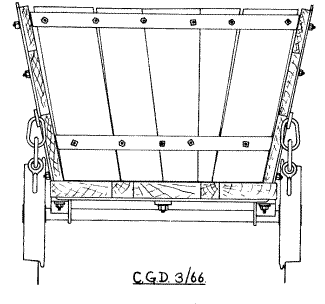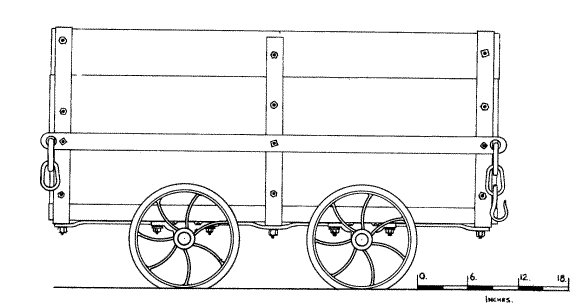
| THE INDUSTRIAL RAILWAY RECORD |
© APRIL 1968 |
NARROW GAUGE WAGONS
| (7) NORTON HILL COLLIERY | C. G. DOWN |
The old shaft at the Norton Hill Colliery in Somerset was sunk to a depth of 1200ft prior to 1850, and small wooden tubs carrying 2cwt were used on 2ft 5½in gauge rails both above and below the surface. These early tubs were replaced by 1903, but some details have survived. The body was 2ft 10in wide, 3ft 6in long and 1ft 10in deep; wheels ordered for them on 8th May 1895 from Sybry, Searls & Co., Cannon Steel Works, Carlisle St., Sheffield for "2ft 5½in fitted gauge, 2ft 6in rail gauge". The gauge of 2ft 5½in is confirmed both by measurement of the existing track and from the records of Greenwood & Batley Ltd. who supplied locomotives of this gauge many years later.
In 1903, the second shaft was sunk to a depth of 1500ft and this, being a much wider structure, allowed the use of larger wagons, one being shown in the drawing. Underground they were horse-hauled for many years and were gradually replaced by steel tubs of 30cwt capacity, which increased the demand on the horses somewhat. One reason for the replacement was the high casualty rate; the Tub Repair Book for 1952 shows that between 30th January and 29th February 358 wooden tub bodies were repaired against only 139 steel ones. Another reason was the introduction in 1952 of three Greenwood & Batley 10 ton battery locomotives, the wooden variety being rather less suited to locomotive haulage than the steel. In 1960, the locomotives were replaced by a conveyor belt up an 870yd gradient of 1 in 4, steel tubs being then used only to bring coal to the surface. Nevertheless the wooden wagons did survive until quite a recent date, a few being retained after replacement for use in carrying equipment.
The wagon in the drawing had a capacity of 8 to 10cwts. The body is 2ft 11½in wide, tapering to 2ft 3in, 4ft 5½in long and 1ft 11¼in deep. The body is bound by three iron straps, with additionally one longitudinal one on each side and another beneath. The wheelbase is 1ft 9¼in and the wheels are of the same pattern as those of 1895 (they may well be the same wheels transferred from the old wagons), being 1ft 0in diameter, 2ft 2¼in back-to-back, and with a 2in tread.
The last coal was wound on 11th February 1966, the last shift finishing work at 20.45 when the colliery was closed. Most of the tubs are to be cut up. It should be mentioned that the wagon depicted is very similar to others used in the Somerset collieries. At the now closed Braysdown Colliery, some derelict tubs on the same gauge are more or less identical, and others at Writhlington and Old Mills collieries are also basically similar.
I should like to thank Mr Beech, the Manager at Norton Hill Colliery, for his help with this article.

